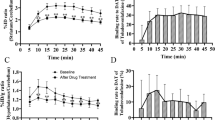Abstract
The in vivo potency of mazindol for binding to striatal dopamine transporters (DAT) was assessed by [123I]β-CIT ([123I]2β-carbomethoxy-3β-(4-iodophenyl)tropane) single photon emission computed tomography (SPECT). Cocaine-dependent subjects (n=12) underwent three SPECT scans; one before, between, and after subchronic (1 week) administration of 2mg/day and 4mg/day mazindol. For each scan, subjects were injected with [123I]β-CIT and imaged 24h later under equilibrium conditions. Results showed a statistically significant main effect of mazindol dose (df=2, F=10.30, P<0.001, repeated measures ANOVA) in reducing the specific to non-displaceable equilibrium partition coefficient, V3″ (a measure proportional to DAT binding potential). Regression analysis of the logit transformed data enabled estimation of the 50% displacement dose of mazindol (ED50 =30mg/ day). These data suggest that low doses of mazindol (i.e., 2–4mg) occupy a small percentage (i.e., <25%) of DAT in human cocaine abusers and that much higher, potentially intolerable doses (i.e., ≥30mg/day) may be required to antagonize significantly cocaine binding in vivo.
Similar content being viewed by others
Author information
Authors and Affiliations
Additional information
Received: 14 November 1996/Final version: 17 December 1997
Rights and permissions
About this article
Cite this article
Malison, R., McCance, E., Carpenter, L. et al. [123I]β-CIT SPECT imaging of dopamine transporter availability after mazindol administration in human cocaine addicts. Psychopharmacology 137, 321–325 (1998). https://doi.org/10.1007/s002130050625
Issue Date:
DOI: https://doi.org/10.1007/s002130050625




